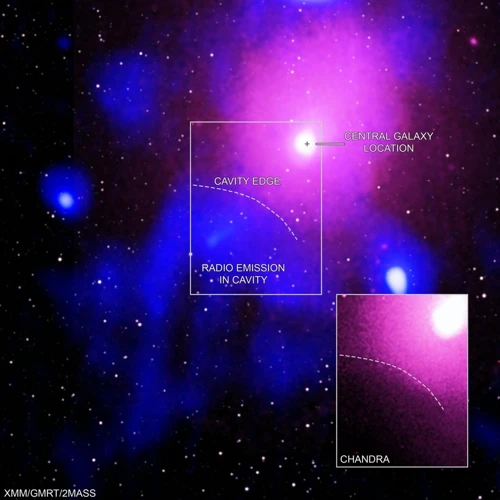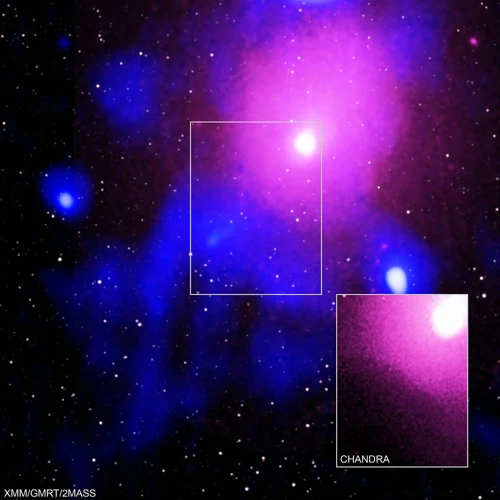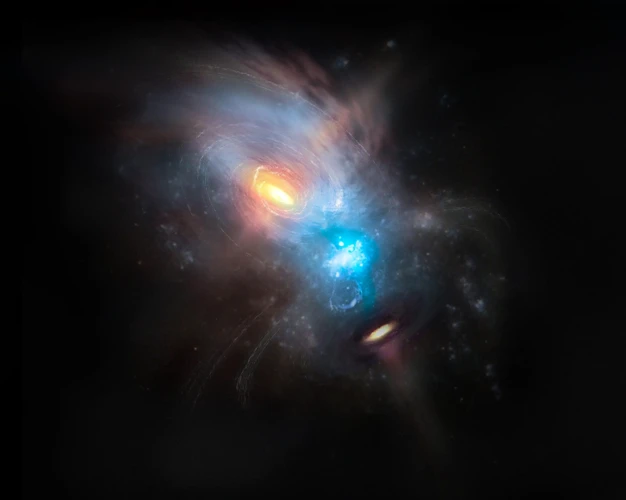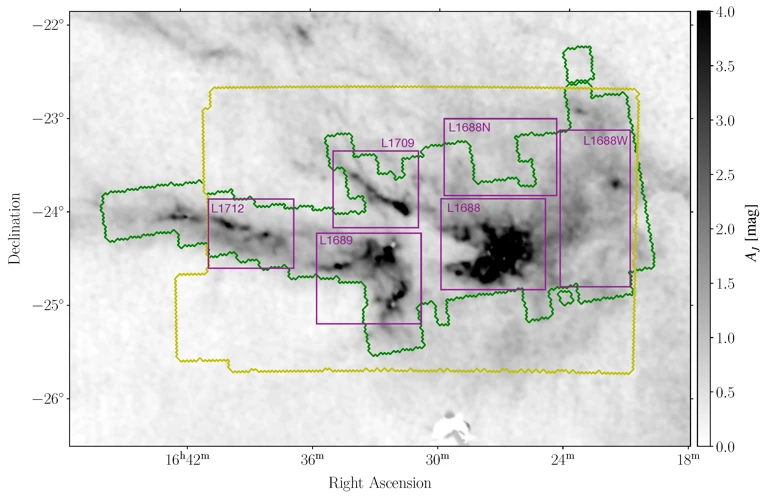Contents
- Understanding the Formation of Galaxies – A Fascinating Journey through Cosmic Origins
- 1. What is a Galaxy?
- 2. Birth of Galaxies
- 3. Building Blocks
- 4. Galaxy Assembly and Mergers
- 5. Conclusion
-
Frequently Asked Questions
- 1. What are the different types of galaxies?
- 2. How do galaxies form?
- 3. What is dark matter’s role in galaxy formation?
- 4. How do stars form within galaxies?
- 5. What triggers the formation of supernovae in galaxies?
- 6. Can galaxies collide?
- 7. What is galactic cannibalism?
- 8. How do astronomers determine the distance to galaxies?
- 9. Can galaxies exist outside of galaxy clusters?
- 10. Are there galaxies outside the observable universe?
- References
-
Frequently Asked Questions
- 1. How many galaxies are there in the universe?
- 2. What are the different types of galaxies?
- 3. How was the Milky Way Galaxy formed?
- 4. What is the Big Bang Theory?
- 5. How are protogalactic clouds formed?
- 6. What is the process of star formation?
- 7. How do supernovae contribute to the formation of galaxies?
- 8. What is the impact of stellar evolution on galaxies?
- 9. How do galaxies assemble and merge?
- 10. What role does dark matter play in galaxy formation?
- References
- Read More
Understanding the Formation of Galaxies – A Fascinating Journey through Cosmic Origins
Exploring the mysteries of the universe, one of the most enigmatic wonders that captivate astronomers and scientists alike are galaxies. These celestial symphonies of stars, gas, and dust hold the key to unraveling the secrets of our cosmic origins. In this captivating journey, we will delve deep into the astounding formation processes that gave birth to these mesmerizing structures. From the mind-boggling theories behind the Big Bang to the intricate interplay of stellar evolution and galactic mergers, join us as we unravel the cosmic ballet that shaped the galaxies we know today. Embark on this incredible voyage of knowledge and awe-inspiring discoveries to understand the magnificent tapestry of galaxies that adorn the night sky.
1. What is a Galaxy?

A galaxy is a vast assemblage of stars, interstellar gas, planets, dust, and dark matter that are bound together by gravity. These awe-inspiring structures come in a variety of shapes, sizes, and compositions, each containing billions to trillions of stars. Galaxies can range from small, dwarf galaxies with only a few million stars to massive elliptical galaxies that house trillions of stars. The formation and evolution of galaxies are governed by intricate astrophysical processes that occur over billions of years. The study of galaxies, known as galactic astronomy, involves observing and analyzing their properties, such as their shapes, sizes, distances, and the types of stars they contain. Through the exploration of galaxies, scientists gain valuable insights into the origins of the universe and the nature of cosmic evolution. To delve deeper into the understanding of galaxies, it is important to explore the different types of galaxies and the intricate details of our own Milky Way galaxy.
1.1 Types of Galaxies
The universe is a vast and mysterious place, filled with a diverse assortment of galaxies. Astronomers have classified galaxies into different types based on their shapes, structures, and characteristics. The three main types of galaxies are:
1. Elliptical galaxies: These galaxies are shaped like ellipsoids or spheres. They are often referred to as “early-type” galaxies because they tend to contain older stars. Elliptical galaxies are typically devoid of significant interstellar gas and dust, and they exhibit little to no ongoing star formation. They range in size from small dwarf ellipticals to massive giant ellipticals that can contain trillions of stars.
2. Spiral galaxies: Spiral galaxies are characterized by their beautiful swirling arms and a central bulge. These galaxies have a flattened disk-like structure with ongoing star formation occurring in their spiral arms. Spiral galaxies often contain a significant amount of interstellar gas and dust, which fuel the formation of new stars. The Milky Way, our home galaxy, is a prime example of a spiral galaxy.
3. Irregular galaxies: As the name suggests, irregular galaxies lack a well-defined shape or structure. They come in a variety of forms and sizes and exhibit irregular patterns of star formation. Irregular galaxies are often the result of galactic interactions, mergers, or gravitational disturbances. These galaxies are known for their vibrant and active star-forming regions, which give them a unique and chaotic appearance.
Within these broad categories, there are further subtypes and variations. Some galaxies exhibit characteristics of more than one type, making classification a complex task. Nevertheless, studying the different types of galaxies provides valuable insights into the diverse evolution and formation processes occurring throughout the universe.
For more information on the influences of astrology and birth charts, you can explore the fascinating field of astrology and its influence on birth charts. However, it is important to note that astrology is separate from the scientific study of galaxies and astronomy.
1.2 The Milky Way Galaxy
The Milky Way Galaxy, our celestial home, is a spiral galaxy that spans approximately 100,000 light-years in diameter. It is composed of billions of stars, gas, dust, and dark matter. Located in the outskirts of the Virgo Supercluster, the Milky Way is just one of the billions of galaxies in the universe. Its name originates from the ancient Greek myth, where it was believed to be the result of a celestial milk spill. Within the Milky Way, our solar system resides, along with other celestial bodies like planets, asteroids, and comets. The galaxy is divided into different components, including the central bulge, the disk, and the halo. The central bulge contains a dense concentration of stars, while the disk is where the spiral arms, filled with young stars and interstellar gas, are found. The halo, surrounding the central bulge and disk, contains older stars and globular clusters. Understanding the Milky Way is crucial as it provides a unique vantage point for studying galaxies and the processes that shape them. Exploring the mysteries of our galaxy opens up opportunities to comprehend the diverse array of galaxies that exist throughout the vast reaches of the universe. To gain a deeper understanding of the Milky Way, astronomers employ various observational techniques, including telescopes and space missions, to map its structure, study its dynamics, and analyze its stellar populations. By unraveling the intricacies of our galaxy, scientists can shed light on the larger cosmic tapestry and our place within it.
2. Birth of Galaxies

Galaxies, those magnificent structures that grace the cosmos, have their origins rooted in the very fabric of the universe. The birth of galaxies can be traced back to the early moments of the universe itself, as encapsulated by the widely accepted Big Bang Theory. According to this theory, the universe originated from a singularity—an infinitely dense and hot point—and expanded rapidly, creating space, time, and matter. As the universe cooled down, primordial matter—mostly hydrogen and helium—began to condense, forming clouds known as protogalactic clouds. Over time, these massive clouds of gas and dust, drawn together by gravity, started to collapse and fragment. Within these fragments, stars were born, the crucial building blocks of galaxies. The birth of galaxies is a complex and ongoing process, with various factors shaping their ultimate form and structure. From the earliest moments of cosmic evolution to the formation of primordial matter and protogalactic clouds, each step plays a vital role in the creation of these awe-inspiring cosmic entities. To gain a deeper understanding of galaxy formation, we delve into the intricate mechanisms of star formation, the life cycles of stars, and the influence of processes such as supernovae and stellar evolution.
2.1 The Big Bang Theory
The Big Bang Theory is the prevailing cosmological model that explains the birth and expansion of our universe. According to this theory, the universe originated from a singular point of immense density and temperature, known as a singularity. Approximately 13.8 billion years ago, this singularity underwent a rapid expansion, releasing an immense amount of energy and giving rise to space, time, and all the matter and energy present in the universe. As the universe expanded, it cooled down, allowing elementary particles to form, such as protons, neutrons, and electrons. These particles eventually combined to form atomic nuclei and, as the universe continued to cool, atoms. The Big Bang Theory provides the foundation for understanding the formation of galaxies because it explains the initial conditions necessary for the creation of matter and the subsequent processes that led to the formation of protogalactic clouds. For more information on how the Big Bang Theory shaped our understanding of the universe and beyond, visit our article on the differences between astrology and astronomy.
2.2 Formation of Primordial Matter
The formation of primordial matter marks a crucial step in understanding the origin of galaxies. According to the prevailing Big Bang Theory, the universe began as a hot, dense, and infinitely small singularity. As the universe expanded and cooled, elementary particles began to form. Initially, there were only a few types of particles, such as quarks and leptons, which eventually combined to form protons, neutrons, and electrons. During this phase, known as nucleosynthesis, the basic building blocks of matter, such as hydrogen and helium, were created. These primordial elements comprised the majority of matter in the early universe.
As the universe continued to expand and cool, gravity played a crucial role in the formation of structures. Small density fluctuations in the early universe served as seeds for the formation of galaxies. Over time, these fluctuations grew denser due to the gravitational attraction, causing matter to clump together. This process is known as hierarchical structure formation.
The formation of primordial matter laid the foundation for the subsequent formation of stars, galaxies, and other cosmic structures. As gravity continued to act on these matter concentrations, they collapsed under their own weight to form protogalactic clouds. These vast reservoirs of gas and dust would serve as the birthplace for stars and the building blocks of galaxies. The intricate interplay between primordial matter, gravity, and the laws of physics set the stage for the stunning tapestry of cosmic structures that we observe today.
Understanding the formation of primordial matter provides valuable insights into the early universe and the processes that shaped the galaxies we see today. By studying the elemental abundances and characteristics of primordial matter, scientists can unravel the mysteries of cosmic evolution and gain a deeper understanding of our place in the vast cosmos. For further exploration on the influence of celestial bodies on human life, you can delve into the intriguing world of numerology and horoscope predictions, which explore the connections between cosmic phenomena and individual personalities.
2.3 Protogalactic Clouds
Protogalactic clouds play a crucial role in the process of galaxy formation. These massive clouds of gas and dust serve as the birthplaces of galaxies. The formation of protogalactic clouds begins when regions of slightly higher density within the vast expanse of the universe start to condense due to gravitational forces. Over time, these regions continue to collapse under their own gravity, causing the gas and dust within them to come together and form dense, compact structures. Within these protogalactic clouds, the gas and dust begin to cool and clump together, creating pockets of even higher density. As the density increases, the process of star formation is initiated, where the gravitational collapse leads to the birth of new stars. These newly forming stars begin to release intense radiation and powerful stellar winds, shaping the surrounding environment and driving the further evolution of the protogalactic cloud. Over millions of years, these protogalactic clouds continue to grow and evolve, accumulating more stars, gas, and dust. Eventually, through the complex interplay of various astrophysical processes, protogalactic clouds transform into fully-fledged galaxies, with their distinct characteristics and structures. The study of protogalactic clouds provides valuable insights into the early stages of galaxy formation and allows scientists to trace the origins of the galaxies we observe in the vast expanse of the universe. For more information on the fascinating interplay of cosmic forces, you can explore the power of numerology and horoscope predictions, which offer unique perspectives on celestial influences in our lives (insert internal HTML link to /exploring-power-numerology-horoscope-predictions/).
3. Building Blocks

Stars are the fundamental building blocks of galaxies. They form within vast clouds of gas and dust known as molecular clouds. As these clouds become denser, gravity starts to take over, causing the material within to collapse under its own weight. As the collapse continues, the core of the cloud becomes hotter and denser, eventually reaching a point where nuclear fusion ignites. This fusion process releases an immense amount of energy, and a new star is born. These young, hot stars emit intense ultraviolet radiation that ionizes the surrounding gas, creating emission nebulae that are often seen in young galaxies.
Supernovae, the explosive deaths of massive stars, play a crucial role in the enrichment of galaxies with heavy elements. When a massive star exhausts its nuclear fuel, its core collapses under gravity, resulting in an incredibly powerful explosion. The energy released by a supernova blast scatters heavy elements, such as carbon, oxygen, and iron, into the surrounding space. These elements mix with the interstellar medium, enriching it with metals. Subsequent generations of stars then form from this enriched material, leading to a gradual increase in the metallicity of galaxies over time.
The evolution of stars within galaxies greatly influences their overall structure and dynamics. Stars with different masses have different lifetimes and evolutionary paths. Massive stars have shorter lifespans and tend to explode as supernovae, whereas lower-mass stars, like our Sun, evolve more slowly and eventually shed their outer layers, forming planetary nebulae. These processes have a profound impact on the chemical composition and energy balance of galaxies. The ejection of matter and energy from dying stars has far-reaching consequences for the interstellar medium, triggering new star formation and shaping the overall structure of galaxies.
Understanding the intricate interplay between star formation, supernovae, and stellar evolution provides valuable insights into the processes that shape galaxies throughout the universe. By studying these building blocks and their impact, astronomers gain a deeper understanding of the lifecycle of galaxies and the remarkable complexity that governs their formation and evolution.
3.1 Star Formation
Stars, the celestial powerhouses of galaxies, are born through a fascinating process known as star formation. This pivotal phenomenon occurs within large molecular clouds, regions of dense interstellar gas and dust. The process begins with the gradual collapse of a small portion of the molecular cloud due to its self-gravity. As the cloud collapses, it fragments into smaller clumps, eventually forming a dense core called a protostar. At this stage, the core is primarily composed of gas and dust and is surrounded by a swirling disk known as an accretion disk. The immense gravitational forces at play within the protostar cause the core to heat up, initiating nuclear fusion. This fusion process ignites the star, causing it to emit intense radiation and powerful stellar winds. The protostar undergoes a dramatic transformation, gradually acquiring mass and evolving into a main sequence star. This is the stage at which the star enters a stable period of its life, where it will burn hydrogen at its core for millions to billions of years, depending on its mass. The process of star formation is a continuous cycle within galaxies, as new stars are constantly being born while older stars reach the end of their life cycles. The study of star formation provides crucial insights into the dynamics and evolution of galaxies, as stars play a central role in shaping the structure and composition of these magnificent cosmic entities.
3.2 Supernovae and Metal Enrichment
Supernovae play a vital role in the evolution and enrichment of galaxies. These explosive events occur when massive stars reach the end of their lives and undergo a catastrophic collapse, releasing an immense amount of energy and ejecting stellar material into space. The intense heat and pressure generated during a supernova cause the fusion of lighter elements, such as hydrogen and helium, into heavier elements, known as metals in astrophysics. These newly formed metals, including carbon, oxygen, nitrogen, and many others, are dispersed into the surrounding interstellar medium through the explosion’s shockwave.
The injection of metals into the interstellar medium is a crucial process for the enrichment of subsequent generations of stars and the building blocks of future galaxies. The presence of these metals affects the chemistry and physical properties of the interstellar medium, providing the necessary ingredients for the formation of new stars and planetary systems. The increased metallicity also influences the characteristics of star formation, including the mass distribution and the formation of multiple star systems.
As more stars go through their life cycles, experiencing supernovae and enriching the interstellar medium with metals, the metallicity of galaxies gradually increases. This progressive enrichment accumulates over time, leading to the gradual evolution of the galaxy’s chemical composition. By studying the metallicity of different regions within a galaxy, astronomers can gain insights into its formation history and the various processes that contributed to its evolution.
The role of supernovae in metal enrichment goes beyond just individual galaxies. In galactic collisions and mergers, where galaxies come together and exchange their stellar populations, the mingling of different metallicities from each galaxy contributes to the overall metal content of the resulting merged galaxy. These interactions further shape the chemical composition and characteristics of galaxies, affecting their star formation rates, morphologies, and overall evolution.
Understanding the impact of supernovae and metal enrichment in galaxy formation is crucial for unraveling the complexities of cosmic evolution. The interplay between stellar processes, such as supernovae, and the eventual distribution of metals throughout galaxies provides valuable insights into the intricate mechanisms that have shaped the vast tapestry of galaxies we observe in our universe.
3.3 Stellar Evolution Impact
Stellar evolution plays a crucial role in the formation and evolution of galaxies, impacting their composition, structure, and dynamics. As stars evolve, they go through various stages, each with its own distinct characteristics and effects on the surrounding environment. One key impact of stellar evolution on galaxies is the production and dispersal of heavy elements through processes such as nucleosynthesis and supernovae explosions. These elements, known as metals in astronomical terms (even though they may not necessarily be metals in the conventional sense), can include elements like carbon, oxygen, nitrogen, and iron. The enrichment of galaxies with these metals is crucial for the formation of new generations of stars and planetary systems. Additionally, as massive stars reach the end of their life cycles, they explode in spectacular supernova events, releasing immense amounts of energy and ejecting material into space. These supernovae explosions can trigger the formation of new stars by compressing nearby gas and dust clouds, kick-starting the cycle of star formation. The energy and radiation produced by evolving stars can influence the surrounding gas and dust, shaping their distribution and dynamics within galaxies. Stellar winds, the streams of charged particles blown off by evolving stars, can also have a significant impact on the interstellar medium, influencing the formation of new stars and the evolution of gas clouds. The processes of stellar evolution have far-reaching consequences for the evolution and characteristics of galaxies, shaping their chemical makeup, driving star formation, and influencing their overall structure and dynamics.
4. Galaxy Assembly and Mergers

Galaxy assembly and mergers play a crucial role in the formation and evolution of galaxies. Over billions of years, galaxies have undergone a dynamic process of growth and transformation through interactions with other galaxies.
4.1 Halo Formation and Dark Matter: Galaxy formation begins with the growth of dark matter halos. Dark matter, which makes up the majority of the mass in the universe, creates gravitational wells that attract ordinary matter. As matter accumulates in these halos, it begins to collapse under its own gravity, forming the initial building blocks of galaxies.
4.2 Galactic Collisions: Galactic collisions occur when two or more galaxies come into close proximity and their gravitational forces cause them to interact. These collisions can result in the disruption of the galaxies’ structures and the formation of new stars. As galaxies merge, their gas, dust, and stars mix together, leading to the creation of larger, more massive galaxies.
4.3 Galaxy Cannibalism: In some cases, a larger galaxy can gravitationally capture smaller galaxies, a process known as galaxy cannibalism. As the smaller galaxies merge with the larger one, their stars and gas become part of the central galaxy, contributing to its growth. This process is particularly prevalent in galaxy clusters, where galaxies are densely packed and interactions are more frequent.
These assembly and merger processes shape the composition, structure, and morphology of galaxies. They also contribute to the formation of features like galactic bars, spiral arms, and central bulges. By studying these interactions, astronomers gain insights into the formation mechanisms and evolutionary paths of galaxies.
Galaxy assembly and mergers are vital processes in the life cycle of galaxies. From the formation of dark matter halos to galactic collisions and cannibalism, these interactions shape the evolution and diversity of galaxies throughout the universe. Understanding these mechanisms is crucial for unraveling the mysteries of our cosmic origins and the complex interplay between galaxies in the vast expanse of space.
4.1 Halo Formation and Dark Matter
In the realm of galaxy formation, the concept of halos and dark matter plays a crucial role. Halo formation is a significant step in the process of galaxy assembly. Halos are vast, roughly spherical regions of dark matter that surround galaxies. Dark matter, which is invisible and does not interact with light, makes up a majority of the mass in these halos. It exerts a gravitational pull, drawing in surrounding matter and providing the foundation for galaxy formation. The presence of dark matter within halos not only helps explain the observed rotation curves of galaxies but also provides the necessary gravitational pull to prevent galaxies from dispersing. The exact nature of dark matter remains a mystery, but its influence on halo formation and galaxy growth is undeniable. Research suggests that the growth of halos and the accretion of surrounding matter are driven by gravitational interactions between dark matter particles. As the dark matter halo grows, it attracts more matter, including gas and smaller dark matter halos, which eventually merge to form a larger, more massive galaxy. The study of halo formation and dark matter continues to challenge scientists and drive our understanding of the universe to new frontiers.
4.2 Galactic Collisions
Galactic collisions are dramatic events that play a crucial role in the formation and evolution of galaxies. When galaxies interact and collide with one another, it can result in a cosmic dance of stars, gas, and gravitational forces. These collisions can occur between galaxies of similar or different sizes. As they merge, the immense gravitational forces at play cause a dynamic reshaping of the galaxies involved. The gravitational interactions can disrupt the stable orbits of stars, leading to new orbits and the formation of tidal tails and bridges. The gas clouds within the galaxies experience compression and shock waves, triggering intense bursts of star formation. The collision between galaxies can also trigger the activation of supermassive black holes at their centers, leading to the release of colossal amounts of energy in the form of quasars or active galactic nuclei. The aftermath of galactic collisions often results in the formation of elliptical galaxies, which have a more randomized arrangement of stars compared to spiral galaxies. These collisions are not destructive but rather transformative, shaping the architecture and structure of galaxies throughout the universe. Through the study of galactic collisions, astronomers gain valuable insights into the mechanisms driving galaxy evolution and the intricate interplay between gravitational forces and astrophysical phenomena.
4.3 Galaxy Cannibalism
When it comes to the formation and evolution of galaxies, one intriguing phenomenon that plays a significant role is galaxy cannibalism. Galaxy cannibalism, also known as galactic mergers or galaxy-galaxy interactions, occurs when two or more galaxies come into close proximity and eventually merge. These interactions can have profound effects on the structure, composition, and dynamics of the galaxies involved.
During a galactic merger, the gravitational forces between the galaxies cause their stars, gas, and dust to interact and merge together. As a result, the galaxies undergo a dramatic transformation, creating a new galaxy with a combination of the original galaxies’ stellar populations. The merging process can trigger intense bursts of star formation as the gas and dust collide, leading to the formation of new stars at an accelerated rate.
Galaxy cannibalism is especially prevalent in rich galaxy clusters, where galaxies are densely packed together. As larger galaxies grow through mergers with smaller galaxies, they consume the stars, gas, and dust of the smaller galaxies, thereby increasing their size and contributing to the diversity of galactic structures within the cluster.
The aftermath of a galactic merger can result in various outcomes. In some cases, the merger may lead to the formation of an elliptical galaxy, characterized by a spheroidal shape and a lack of distinct spiral arms. In other instances, the merger can give rise to a galaxy with irregular or distorted features, known as a peculiar galaxy. These peculiar galaxies often exhibit asymmetrical shapes and peculiar distributions of stars.
The process of galaxy cannibalism is a crucial component of galaxy evolution. It helps shape the structures and dynamics of galaxies, influences their star formation histories, and contributes to the overall growth of galaxies over cosmic timescales. By studying the aftermath of galactic mergers and the properties of resulting galaxies, scientists gain valuable insights into the mechanisms that govern the formation and evolution of galaxies throughout the universe.
5. Conclusion

Delving into the formation of galaxies is a captivating journey that takes us back to the origins of the universe. From the mind-boggling theories of the Big Bang to the intricate processes of star formation and galactic mergers, we begin to comprehend the grand tapestry of celestial structures that adorn our night sky. The study of galaxies unveils the secrets of cosmic evolution and provides invaluable insights into the vastness and complexity of the universe. By exploring different types of galaxies and unraveling the intricate details of our own Milky Way galaxy, we gain a deeper understanding of the forces that shape these celestial bodies. As we continue to probe the depths of the cosmos, advancements in technology and astronomical observations have the potential to yield groundbreaking discoveries, expanding our knowledge and allowing us to unravel even more mysteries of galactic formation. So, let us embrace the wonders of the universe and embark on a never-ending quest to comprehend the mesmerizing formations of galaxies.
Frequently Asked Questions

1. What are the different types of galaxies?
There are three main types of galaxies: spiral, elliptical, and irregular. Spiral galaxies, like our Milky Way, have a distinct spiral structure. Elliptical galaxies are round or oval in shape and lack any prominent features. Irregular galaxies have irregular shapes and can range from small to large.
2. How do galaxies form?
Galaxies are believed to form through the process of cosmic evolution. It starts with the Big Bang, which created the universe and its initial distribution of matter and energy. Over time, gravity causes matter to clump together, forming protogalactic clouds. Within these clouds, stars form, and eventually, they merge to create galaxies.
3. What is dark matter’s role in galaxy formation?
Dark matter has a significant role in galaxy formation. It provides the gravitational framework for ordinary matter to gather and form galaxies. The exact nature of dark matter is still a mystery, but its presence is crucial in explaining the structure and rotation of galaxies.
4. How do stars form within galaxies?
Stars form within galaxies from the gravitational collapse of dense regions within protogalactic clouds. These regions, known as molecular clouds, undergo gravitational collapse, causing gas and dust to come together and form new stars. Stellar nurseries within galaxies are responsible for the continuous birth of stars.
5. What triggers the formation of supernovae in galaxies?
Supernovae occur when massive stars reach the end of their lives and undergo a powerful explosion. These explosions can be triggered by various factors, including the depletion of their nuclear fuel, the collapse of their core, or a transfer of mass from a companion star in a binary system.
6. Can galaxies collide?
Yes, galaxies can collide with one another. When galaxies approach each other due to gravitational interactions, their immense sizes do not prevent them from merging. Galactic collisions can result in the formation of new galaxies with distorted shapes and trigger intense star formation.
7. What is galactic cannibalism?
Galactic cannibalism refers to the process where a larger galaxy assimilates a smaller galaxy. The gravitational forces between the two galaxies cause tidal interactions, leading to the smaller galaxy being torn apart and eventually consumed by the larger one.
8. How do astronomers determine the distance to galaxies?
Astronomers use various methods to determine the distance to galaxies. One common method is using Cepheid variable stars, which pulsate at a rate that is directly related to their intrinsic brightness. By comparing their observed brightness with their known intrinsic brightness, astronomers can calculate the distance to the galaxy they reside in.
9. Can galaxies exist outside of galaxy clusters?
Yes, galaxies can exist both within and outside of galaxy clusters. A galaxy cluster is a large assembly of galaxies held together by gravity. However, there are also individual galaxies or small groups of galaxies that are not part of a larger cluster.
10. Are there galaxies outside the observable universe?
It is possible that there are galaxies outside of the observable universe. The observable universe only encompasses the portion of the universe that we can potentially observe due to the limitations imposed by the speed of light. There may be vast regions beyond our observational reach that contain galaxies and other cosmic structures.
References
- The Formation of Galaxies
- Galaxy Formation and Evolution | Harvard & Smithsonian
- The Formation and Evolution of Galaxies and Structure in …
Frequently Asked Questions

1. How many galaxies are there in the universe?
The exact number of galaxies in the universe is unknown, but estimates suggest that there could be anywhere between 100 billion to 200 billion galaxies.
2. What are the different types of galaxies?
The different types of galaxies include spiral galaxies, elliptical galaxies, lenticular galaxies, and irregular galaxies.
3. How was the Milky Way Galaxy formed?
The Milky Way Galaxy was formed by the gravitational collapse of a giant molecular cloud approximately 13.6 billion years ago.
4. What is the Big Bang Theory?
The Big Bang Theory is the prevailing scientific explanation for the origin of the universe. It suggests that the universe began as a singularity and has been expanding ever since.
5. How are protogalactic clouds formed?
Protogalactic clouds are formed through the cooling and condensation of gas and dust in the early universe. These clouds eventually collapse under their own gravity and give rise to galaxies.
6. What is the process of star formation?
Star formation occurs when a dense region within a protogalactic cloud undergoes gravitational collapse. As the collapse continues, the material forms a protostar, which eventually evolves into a main sequence star.
7. How do supernovae contribute to the formation of galaxies?
Supernovae, the explosive deaths of massive stars, play a crucial role in the formation of galaxies. They release heavy elements into the interstellar medium, enriching it with metals necessary for the formation of new stars and planets.
8. What is the impact of stellar evolution on galaxies?
Stellar evolution, the life cycle of stars, influences the overall structure and composition of galaxies. As stars evolve and eventually die, they release energy, enrich the interstellar material, and can trigger the formation of new stars.
9. How do galaxies assemble and merge?
Galaxies assemble and merge through the gravitational interactions between galaxies. Over time, smaller galaxies can be absorbed by larger ones, leading to the growth and evolution of galaxies.
10. What role does dark matter play in galaxy formation?
Dark matter, a mysterious substance that does not interact with light, is thought to play a significant role in galaxy formation. Its gravitational influence helps shape the distribution of matter in galaxies and contributes to the formation of galactic halos.







